|
|
|
Sort Order |
|
|
|
Items / Page
|
|
|
|
|
|
|
| Srl | Item |
| 1 |
ID:
089320
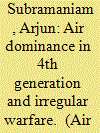

|
|
|
| 2 |
ID:
130523
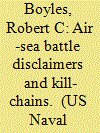

|
|
|
| 3 |
ID:
107895
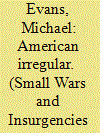

|
|
|
|
|
| Publication |
2011.
|
| Summary/Abstract |
This article examines the portrayal of frontier conflict in American writer, Cormac McCarthy's 1985 novel, Blood Meridian, or the Evening Redness in the West. It argues that McCarthy's work is one of the most profound American literary meditations ever composed on the subject of irregular conflict. The article traces the novel's literary antecedents and historical background and analyses its use of language, its structural narrative, and its lyrical descriptions of bloodshed and extreme guerrilla violence on the Texas-Mexican frontier in the mid nineteenth century. Particular attention is paid to McCarthy's development of a philosophy of war, which is related to the Counter-Enlightenment ideas of Joseph de Maistre and Friedrich Nietzsche. It is suggested that McCarthy employs the experience of irregular conflict on the American frontier as a philosophical lens to articulate the idea of war as a form of divination - an approach that is based on a mixture of Maistre's theory of redemptive violence and Nietzsche's cult of the existential warrior. The article concludes that McCarthy's blending of irregular conflict with a philosophy of war - empowered as it is by some of the most sumptuous of all twentieth-century American literary prose - endow this classic novel with a timeless and transcendental quality. McCarthy's unflinching representation of the anatomy of irregular conflict thus emerges not only as a searing portrayal of America's past frontier experience, but also as a powerful metaphor for understanding the endemic violence of twenty-first century insurgency in such countries as Iraq and Afghanistan.
|
|
|
|
|
|
|
|
|
|
|
|
|
|
|
|
| 4 |
ID:
064976
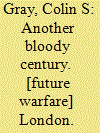

|
|
|
|
|
| Publication |
London, WeidenFeld and Nicolson, 2005.
|
| Description |
431p.Hbk
|
| Standard Number |
0297846272
|
|
|
|
|
|
|
|
|
|
|
|
Copies: C:1/I:0,R:0,Q:0
Circulation
| Accession# | Call# | Current Location | Status | Policy | Location |
| 049914 | 909.83/GRA 049914 | Main | On Shelf | General | |
|
|
|
|
| 5 |
ID:
181752
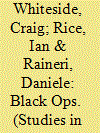

|
|
|
|
|
| Summary/Abstract |
This paper studies non-state militant group emulation and development of a special operation capability that stands in stark contrast to the normal repertoire of guerilla and terror tactics. Building on evidence of one well-documented Islamic State attack in 2012 that fit many of the criteria of a special operation, we analyzed the mission using concepts from strategic studies to understand the decision-making behind it. We then expanded our search of Islamic State operational claims looking for other examples, in order to understand the scope and frequency of Islamic State special operations since 2006. We found solid evidence of at least three Islamic State special operations over a decade: Ramadi, Iraq (2007), Haditha, Iraq (2012), and Abu Ghraib/Taji, Iraq (2013). Using these insights, we present two key levers – leadership and propaganda - used by the Islamic State in the decision-making and centralized distribution of resources to invest in a special operations capability that produced outsized strategic effects. These findings contest the conventional wisdom of the future of insurgency as decentralized structures made up of loose, leaderless networks.
|
|
|
|
|
|
|
|
|
|
|
|
|
|
|
|
| 6 |
ID:
108608


|
|
|
| 7 |
ID:
120300
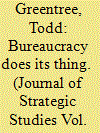

|
|
|
|
|
| Publication |
2013.
|
| Summary/Abstract |
It is not too soon to draw cautionary lessons from the inconclusive results of US performance during more than 11 years of Operation 'Enduring Freedom' in Afghanistan. As in Vietnam, fundamental difficulties persist in adapting enduring institutions to the requirements of strategy. At the heart of the matter is tension between the assumptions that underlie counterinsurgency as practiced in Afghanistan and organization of the US Armed Forces, State Department, and Agency for International Development. Knowledge of basic principles and necessary changes is available to answer the question, could the US have done better?
|
|
|
|
|
|
|
|
|
|
|
|
|
|
|
|
| 8 |
ID:
144335
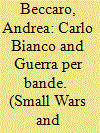

|
|
|
|
|
| Summary/Abstract |
Since the end of the Cold War, a huge debate over how war has been changing has emerged; a common feature is that modern conflicts are not state vs. state wars, but ‘irregular wars’. In order to better understand modern irregular warfare, it is important to analyse past authors and ideas. Carlo Bianco’s concept of Guerra per bande highlights elements of mobility with different cooperating units, of terror, and of complex terrain. The present study offers the first English analysis of Carlo Bianco and underlines the similarities of his work to the hybrid warfare concept.
|
|
|
|
|
|
|
|
|
|
|
|
|
|
|
|
| 9 |
ID:
071237
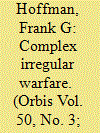

|
|
|
| 10 |
ID:
107666
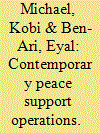

|
|
|
|
|
| Publication |
2011.
|
| Summary/Abstract |
In this article the authors examine two set of issues that constrain contemporary peace support operations (PSOs): one centered on the kinds of knowledge prevalent in PSOs and the second involving the organizational structures that characterize them. The authors' aim is to show the deep discursive and structural limitations and contradictions that continue to characterize the actions of armed forces and the dominance of militaristic thinking within PSOs. This article centers on multidimensional peacekeeping marked by emphasizing two main points in regard to the complex nature of such peacekeeping. First, Western military thinking is still dominant in the professional discourse of peacekeeping despite the fact that in many cases it is less relevant to the arenas where it is applied (in weakened or failed states). Second, forces in second-generation peacekeeping missions are by definition a form of hybrid organizations, and therefore conceptual changes in regard to PSOs not only involve the realm of knowledge but also entail practical consequences for the very organizational means used to achieve their aims. The authors' analysis demonstrates the blending, hybridization, and linkages that are an essential part of PSOs as processes that carry both advantages and disadvantages for organizational action.
|
|
|
|
|
|
|
|
|
|
|
|
|
|
|
|
| 11 |
ID:
193168
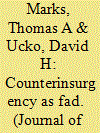

|
|
|
|
|
| Summary/Abstract |
The counterinsurgency era that dominated American military discussion post-9/11 has passed. The desire to move on, particularly since the loss of Afghanistan in August 2021, has left unsettled a conversation on counterinsurgency that, both among supporters and detractors, was often dangerously narrow. Too hastily embraced and too rapidly abandoned, counterinsurgency generated false promises and then became the scapegoat for poor strategy. This article examines the counterinsurgency era that was and demonstrates how fad-like engagement with the topic in both military and academic circles subverted the supposed learning process taking place. It argues that the lessons from this engagement are mostly misleading or at least incomplete, but it also notes that there is minimal appetite to look deeper into a topic now deemed toxic. Therein lies significant danger.
|
|
|
|
|
|
|
|
|
|
|
|
|
|
|
|
| 12 |
ID:
134168
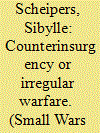

|
|
|
|
|
| Publication |
2014.
|
| Summary/Abstract |
This article argues that the history of irregular warfare provides a valuable analytical and critical perspective for the study of counterinsurgency campaigns and counterinsurgency doctrine. A focus on the history of irregular warfare highlights the close relationship between warfare in Europe and in the colonies. Moreover, it enables us to identify more exactly the intersection of multiple factors that lead to an escalation of violence in small wars. Finally, it also sheds light on the lack of strategic reflection on the use of irregular auxiliaries that is characteristic for many counterinsurgency campaigns.
|
|
|
|
|
|
|
|
|
|
|
|
|
|
|
|
| 13 |
ID:
132723
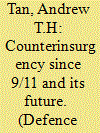

|
|
|
|
|
| Publication |
2014.
|
| Summary/Abstract |
Recent US experience in Iraq and Afghanistan has proven that COIN, however revised and updated to fit the globalised era in which we live, is a problematic and ineffective solution to the irregular warfare waged by insurgents. The United States and the West in general will have to accept the chastening lessons of Iraq and Afghanistan lest they repeat it: that they are not good at waging COIN and must try to avoid getting involved in such costly campaigns again. If intervention abroad has to be undertaken, it will have to fulfill a set of demanding conditions. Nonetheless, while COIN in its contemporary guise has failed to deliver long-term, tangible results, thinking about how to counter asymmetric challenges, including the waging of irregular warfare, cannot be ignored, given the likelihood that external interventions will continue to be required in the future. Moreover, while COIN as the basis of a grand strategy is unrealistic, some of its basic principles are useful in orientating future approaches to insurgencies and terrorism towards comprehensive and collaborative approaches, as opposed to merely hard security operations unilaterally undertaken by States, which fail to address the underlying fundamental causes of political violence and which undermine long-term legitimacy
|
|
|
|
|
|
|
|
|
|
|
|
|
|
|
|
| 14 |
ID:
105837
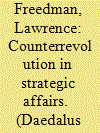

|
|
|
| 15 |
ID:
106609
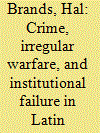

|
|
|
|
|
| Publication |
2011.
|
| Summary/Abstract |
This article examines the current crisis in Guatemala as a case study in the phenomenon of "criminal insurgency" in Latin America. Since the close of Guatemala's civil war in 1996, crime-especially violent crime-has increased dramatically, to the point that drug traffickers, organized crime syndicates, and youth gangs are effectively waging a form of irregular warfare against the state. The police, the judiciary, and entire local and departmental governments are rife with criminal infiltrators; murder statistics have surpassed civil-war levels in recent years; criminal operatives assassinate government officials and troublesome members of the political class; and chunks of territory are now effectively under the control of criminal groups. All this has led to growing civic disillusion and eroded the authority and legitimacy of the government. Rampant crime is causing a crisis of the democratic state.
|
|
|
|
|
|
|
|
|
|
|
|
|
|
|
|
| 16 |
ID:
155028
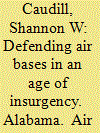

|
|
|
|
|
| Publication |
Alabama, Air University Press, 2014.
|
| Description |
xxxii, 410p.pbk
|
| Standard Number |
9781585662418
|
|
|
|
|
|
|
|
|
|
|
|
Copies: C:1/I:0,R:0,Q:0
Circulation
| Accession# | Call# | Current Location | Status | Policy | Location |
| 059183 | 358.414/CAU 059183 | Main | On Shelf | General | |
|
|
|
|
| 17 |
ID:
096862
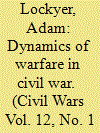

|
|
|
|
|
| Publication |
2010.
|
| Summary/Abstract |
This article explains theoretically, and demonstrates empirically, the instrumental role of the balance of capabilities in shaping the form of warfare that develops in civil wars. It contends that the current common practice of labelling civil wars as either 'guerrilla' or 'conventional' (which is usually meant to accurately characterise the type of warfare throughout an entire civil war) is unable to fully encapsulate the dynamic nature of warfare in civil war. It is instead argued that the form of warfare frequently varies significantly across time and space in a single conflict. This article is divided into three sections. Section one examines recent advances in the understanding of warfare in civil wars. It identifies three categories of warfare in civil war: conventional, guerrilla and irregular. Section two builds on previous studies to develop the concept of the balance of capabilities. Finally, the article illustrates these theoretical insights through a discussion of the American and Somali Civil Wars.
|
|
|
|
|
|
|
|
|
|
|
|
|
|
|
|
| 18 |
ID:
134433
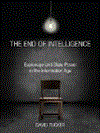

|
|
|
|
|
| Publication |
Stanford, Stanford University Press, 2014.
|
| Description |
241p.Pbk
|
| Contents |
Includes bibliographical references and index
|
| Standard Number |
9780804792653
|
|
|
|
|
|
|
|
|
|
|
|
Copies: C:1/I:0,R:0,Q:0
Circulation
| Accession# | Call# | Current Location | Status | Policy | Location |
| 057935 | 327.12/TUC 057935 | Main | On Shelf | General | |
|
|
|
|
| 19 |
ID:
120315
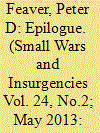

|
|
|
|
|
| Publication |
2013.
|
| Summary/Abstract |
The field has traditionally studied civil-military relations in one of two domains: supreme command, where the great questions of war and peace were decided by the top leaders, or society, where the military institutions sought to establish themselves in relations to the broader civilian world. This special edition emphasizes a third domain: the modern battlefield of complex operations. In that setting the lines between civilian and military are even more blurred than in traditional settings (where they were already quite blurred), and concerns about effectiveness cannot be ignored for the sake of the traditional focus on control.
|
|
|
|
|
|
|
|
|
|
|
|
|
|
|
|
| 20 |
ID:
119498
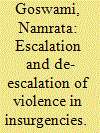

|
|
|
|
|
| Publication |
2013.
|
| Summary/Abstract |
Insurgencies in the Northeast of India have been a recurring phenomenon since India's independence in 1947. One of the most significant aspects of the multiple insurgencies has been the use of violence for political goals. By drawing upon three cases of insurgencies in Northeast India, the article offers a conceptual framework on escalation and de-escalation of violence in insurgencies. The article argues that the most critical variables which have a direct bearing on the levels of insurgent violence are: popular support, loss of legitimacy and the state's counter-response.
|
|
|
|
|
|
|
|
|
|
|
|
|
|
|
|
|
|
|
|
|